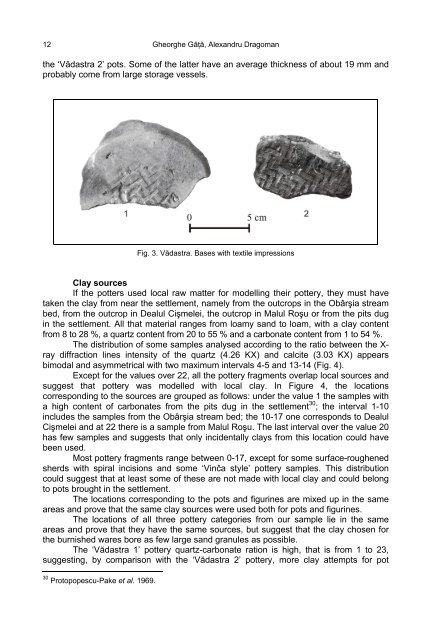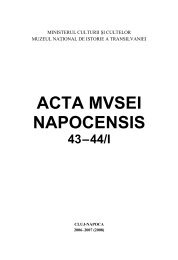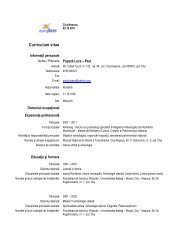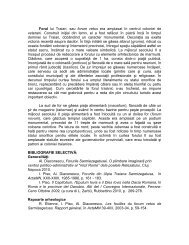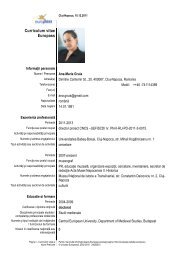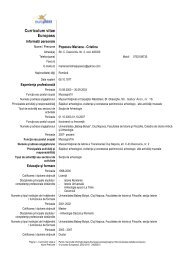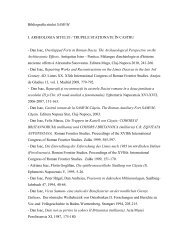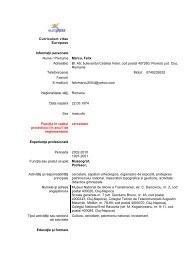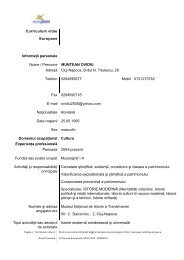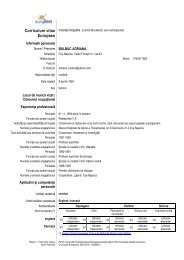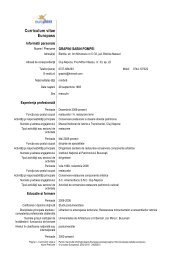- Page 1 and 2: MINISTERUL CULTURII ªI CULTELOR MU
- Page 3 and 4: CONTENTS - INHALT - SOMMAIRE Gheorg
- Page 5 and 6: Gheorghe GâŃă, Alexandru Dragoma
- Page 7 and 8: THE NEOLITHIC POTTERY FROM VĂDASTR
- Page 9 and 10: THE NEOLITHIC POTTERY FROM VĂDASTR
- Page 11: THE NEOLITHIC POTTERY FROM VĂDASTR
- Page 15 and 16: THE NEOLITHIC POTTERY FROM VĂDASTR
- Page 17 and 18: THE NEOLITHIC POTTERY FROM VĂDASTR
- Page 19 and 20: THE NEOLITHIC POTTERY FROM VĂDASTR
- Page 21 and 22: THE NEOLITHIC POTTERY FROM VĂDASTR
- Page 23 and 24: THE NEOLITHIC POTTERY FROM VĂDASTR
- Page 25 and 26: THE NEOLITHIC POTTERY FROM VĂDASTR
- Page 27 and 28: THE NEOLITHIC POTTERY FROM VĂDASTR
- Page 29 and 30: THE NEOLITHIC POTTERY FROM VĂDASTR
- Page 31 and 32: THE NEOLITHIC POTTERY FROM VĂDASTR
- Page 33 and 34: Vitalie Bârcă OBSERVATIONS ON THE
- Page 35 and 36: OBSERVATIONS ON THE SITUATION IN TH
- Page 37 and 38: OBSERVATIONS ON THE SITUATION IN TH
- Page 39 and 40: OBSERVATIONS ON THE SITUATION IN TH
- Page 41 and 42: OBSERVATIONS ON THE SITUATION IN TH
- Page 43 and 44: OBSERVATIONS ON THE SITUATION IN TH
- Page 45 and 46: OBSERVATIONS ON THE SITUATION IN TH
- Page 47 and 48: Gelu A. Florea, Iosif V. Ferencz UN
- Page 49 and 50: UN NOUVEAU «BOUCLIER» DE LA FIN D
- Page 51 and 52: UN NOUVEAU «BOUCLIER» DE LA FIN D
- Page 53 and 54: UN NOUVEAU «BOUCLIER» DE LA FIN D
- Page 55 and 56: Florian Matei-Popescu ON THE PRESEN
- Page 57 and 58: THE COHORT IX BATAVORUM MILLIARIA E
- Page 59 and 60: THE COHORT IX BATAVORUM MILLIARIA E
- Page 61 and 62: Werner Eck, Andreas Pangerl EIN DIP
- Page 63 and 64:
EIN DIPLOM FÜR DIE TRUPPEN VON DAC
- Page 65 and 66:
EIN DIPLOM FÜR DIE TRUPPEN VON DAC
- Page 67 and 68:
EIN DIPLOM FÜR DIE TRUPPEN VON DAC
- Page 69 and 70:
Dan Dana TRADITIONS ONOMASTIQUES, B
- Page 71 and 72:
TRADITIONS ONOMASTIQUES, BRASSAGES
- Page 73 and 74:
TRADITIONS ONOMASTIQUES, BRASSAGES
- Page 75 and 76:
Felix Marcu PLACES OF WORSHIP IN FO
- Page 77 and 78:
PLACES OF WORSHIP IN FORTS 77 Conse
- Page 79 and 80:
Fig. 3.1. Fig. 2.1. PLACES OF WORSH
- Page 81 and 82:
c j PLACES OF WORSHIP IN FORTS 81 i
- Page 83 and 84:
PLACES OF WORSHIP IN FORTS 83 conte
- Page 85 and 86:
PLACES OF WORSHIP IN FORTS 85 know
- Page 87 and 88:
PLACES OF WORSHIP IN FORTS 87 Fig.
- Page 89 and 90:
PLACES OF WORSHIP IN FORTS 89 On th
- Page 91 and 92:
PLACES OF WORSHIP IN FORTS 91 comme
- Page 93 and 94:
PLACES OF WORSHIP IN FORTS 93 preci
- Page 95 and 96:
PLACES OF WORSHIP IN FORTS 95 the t
- Page 97 and 98:
PLACES OF WORSHIP IN FORTS 97 The c
- Page 99 and 100:
PLACES OF WORSHIP IN FORTS 99 disco
- Page 101 and 102:
PLACES OF WORSHIP IN FORTS 101 The
- Page 103 and 104:
PLACES OF WORSHIP IN FORTS 103 be i
- Page 105 and 106:
PLACES OF WORSHIP IN FORTS 105 Petr
- Page 107 and 108:
Irina Nemeti, Sorin Nemeti PLANETS,
- Page 109 and 110:
PLANETS, GRADES AND SOTERIOLOGY IN
- Page 111 and 112:
fig. 1 PLANETS, GRADES AND SOTERIOL
- Page 113 and 114:
PLANETS, GRADES AND SOTERIOLOGY IN
- Page 115 and 116:
PLANETS, GRADES AND SOTERIOLOGY IN
- Page 117 and 118:
PLANETS, GRADES AND SOTERIOLOGY IN
- Page 119 and 120:
PLANETS, GRADES AND SOTERIOLOGY IN
- Page 121 and 122:
PLANETS, GRADES AND SOTERIOLOGY IN
- Page 123 and 124:
PLANETS, GRADES AND SOTERIOLOGY IN
- Page 125 and 126:
IoniŃă-Augustin Petiş THE CENTUR
- Page 127 and 128:
THE CENTURIONS’ PROMOTION SYSTEM.
- Page 129 and 130:
THE CENTURIONS’ PROMOTION SYSTEM.
- Page 131 and 132:
THE CENTURIONS’ PROMOTION SYSTEM.
- Page 133 and 134:
THE CENTURIONS’ PROMOTION SYSTEM.
- Page 135 and 136:
THE CENTURIONS’ PROMOTION SYSTEM.
- Page 137 and 138:
THE CENTURIONS’ PROMOTION SYSTEM.
- Page 139 and 140:
THE CENTURIONS’ PROMOTION SYSTEM.
- Page 141 and 142:
Ovidiu łentea AUXILIA COMMAGENORUM
- Page 143 and 144:
AUXILIA COMMAGENORUM IN DACIA 143 I
- Page 145 and 146:
AUXILIA COMMAGENORUM IN DACIA 145 o
- Page 147 and 148:
AUXILIA COMMAGENORUM IN DACIA 147 a
- Page 149 and 150:
AUXILIA COMMAGENORUM IN DACIA 149 a
- Page 151 and 152:
AUXILIA COMMAGENORUM IN DACIA 151 f
- Page 153 and 154:
AUXILIA COMMAGENORUM IN DACIA 153 a
- Page 155 and 156:
AUXILIA COMMAGENORUM IN DACIA 155 T
- Page 157 and 158:
AUXILIA COMMAGENORUM IN DACIA 157 D
- Page 159 and 160:
AUXILIA COMMAGENORUM IN DACIA 159 P
- Page 161 and 162:
Paul Franzen, Alexandru V. Matei, F
- Page 163 and 164:
THE ROMAN FORT AT ROMITA (DACIA). R
- Page 165 and 166:
THE ROMAN FORT AT ROMITA (DACIA). R
- Page 167 and 168:
THE ROMAN FORT AT ROMITA (DACIA). R
- Page 169 and 170:
THE ROMAN FORT AT ROMITA (DACIA). R
- Page 171 and 172:
THE ROMAN FORT AT ROMITA (DACIA). R
- Page 173 and 174:
THE ROMAN FORT AT ROMITA (DACIA). R
- Page 175 and 176:
THE ROMAN FORT AT ROMITA (DACIA). R
- Page 177 and 178:
THE ROMAN FORT AT ROMITA (DACIA). R
- Page 179 and 180:
Ioan Piso UN NOUVEAU CONDUCTOR SALI
- Page 181 and 182:
UN NOUVEAU CONDUCTOR SALINARUM EN D
- Page 183 and 184:
Ioan Piso STUDIA POROLISSENSIA (II)
- Page 185 and 186:
STUDIA POROLISSENSIA (II) 185 [ara]
- Page 187 and 188:
STUDIA POROLISSENSIA (II) 187 Namen
- Page 189 and 190:
Radu Ardevan ENCORE UNE INSCRIPTION
- Page 191 and 192:
ENCORE UNE INSCRIPTION RÉUTILISÉE
- Page 193 and 194:
ENCORE UNE INSCRIPTION RÉUTILISÉE
- Page 195 and 196:
Viorica Rusu-BolindeŃ NEW DATA ON
- Page 197 and 198:
NEW DATA ON THE IMPORTED TERRA SIGI
- Page 199 and 200:
NEW DATA ON THE IMPORTED TERRA SIGI
- Page 201 and 202:
NEW DATA ON THE IMPORTED TERRA SIGI
- Page 203 and 204:
NEW DATA ON THE IMPORTED TERRA SIGI
- Page 205 and 206:
NEW DATA ON THE IMPORTED TERRA SIGI
- Page 207 and 208:
NEW DATA ON THE IMPORTED TERRA SIGI
- Page 209 and 210:
NEW DATA ON THE IMPORTED TERRA SIGI
- Page 211 and 212:
NEW DATA ON THE IMPORTED TERRA SIGI
- Page 213 and 214:
NEW DATA ON THE IMPORTED TERRA SIGI
- Page 215 and 216:
NEW DATA ON THE IMPORTED TERRA SIGI
- Page 217 and 218:
NEW DATA ON THE IMPORTED TERRA SIGI
- Page 219 and 220:
NEW DATA ON THE IMPORTED TERRA SIGI
- Page 221 and 222:
NEW DATA ON THE IMPORTED TERRA SIGI
- Page 223 and 224:
NEW DATA ON THE IMPORTED TERRA SIGI
- Page 225 and 226:
NEW DATA ON THE IMPORTED TERRA SIGI
- Page 227 and 228:
NEW DATA ON THE IMPORTED TERRA SIGI
- Page 229 and 230:
NEW DATA ON THE IMPORTED TERRA SIGI
- Page 231 and 232:
NEW DATA ON THE IMPORTED TERRA SIGI
- Page 233 and 234:
NEW DATA ON THE IMPORTED TERRA SIGI
- Page 235 and 236:
TERRA SIGILLATA WORKSHOPS LATE ITAL
- Page 237 and 238:
NO. CATALOGUE SGILLATA TYPE POTTER/
- Page 239 and 240:
NEW DATA ON THE IMPORTED TERRA SIGI
- Page 241 and 242:
NEW DATA ON THE IMPORTED TERRA SIGI
- Page 243 and 244:
NEW DATA ON THE IMPORTED TERRA SIGI
- Page 245 and 246:
NEW DATA ON THE IMPORTED TERRA SIGI
- Page 247 and 248:
NEW DATA ON THE IMPORTED TERRA SIGI
- Page 249 and 250:
NEW DATA ON THE IMPORTED TERRA SIGI
- Page 251 and 252:
Cornel Mărcuş, Radu Zăgreanu NEW
- Page 253 and 254:
NEW MONUMENTS DISPLAYING FUNERAL BA
- Page 255 and 256:
NEW MONUMENTS DISPLAYING FUNERAL BA
- Page 257 and 258:
NEW MONUMENTS DISPLAYING FUNERAL BA
- Page 259 and 260:
NEW MONUMENTS DISPLAYING FUNERAL BA
- Page 261 and 262:
Franz Humer, Cristian Găzdac THE H
- Page 263 and 264:
THE HOARD FROM HAUS I IN THE CIVILI
- Page 265 and 266:
THE HOARD FROM HAUS I IN THE CIVILI
- Page 267 and 268:
THE HOARD FROM HAUS I IN THE CIVILI
- Page 269 and 270:
THE HOARD FROM HAUS I IN THE CIVILI
- Page 271 and 272:
THE HOARD FROM HAUS I IN THE CIVILI
- Page 273 and 274:
THE HOARD FROM HAUS I IN THE CIVILI
- Page 275 and 276:
THE HOARD FROM HAUS I IN THE CIVILI
- Page 277 and 278:
THE HOARD FROM HAUS I IN THE CIVILI
- Page 279 and 280:
THE HOARD FROM HAUS I IN THE CIVILI
- Page 281 and 282:
THE HOARD FROM HAUS I IN THE CIVILI
- Page 283 and 284:
Mint/Issuer Diocletianus Maximianus
- Page 285 and 286:
Hoard THE HOARD FROM HAUS I IN THE
- Page 287 and 288:
THE HOARD FROM HAUS I IN THE CIVILI
- Page 289 and 290:
THE HOARD FROM HAUS I IN THE CIVILI
- Page 291 and 292:
Andrei Măgureanu, Bogdan Ciupercă
- Page 293 and 294:
THE 6 th - 8 th CENTURIES METALLURG
- Page 295 and 296:
THE 6 th - 8 th CENTURIES METALLURG
- Page 297 and 298:
THE 6 th - 8 th CENTURIES METALLURG
- Page 299 and 300:
THE 6 th - 8 th CENTURIES METALLURG
- Page 301 and 302:
THE 6 th - 8 th CENTURIES METALLURG
- Page 303 and 304:
THE 6 th - 8 th CENTURIES METALLURG
- Page 305 and 306:
THE 6 th - 8 th CENTURIES METALLURG
- Page 307 and 308:
THE 6 th - 8 th CENTURIES METALLURG
- Page 309 and 310:
THE 6 th - 8 th CENTURIES METALLURG
- Page 311 and 312:
THE 6 th - 8 th CENTURIES METALLURG
- Page 313 and 314:
THE 6 th - 8 th CENTURIES METALLURG
- Page 315 and 316:
THE 6 th - 8 th CENTURIES METALLURG
- Page 317 and 318:
THE 6 th - 8 th CENTURIES METALLURG
- Page 319 and 320:
ABBREVIATIONS - ABKÜRZUNGEN - ABR
- Page 321 and 322:
ABBREVIATIONS - ABKÜRZUNGEN - ABR


